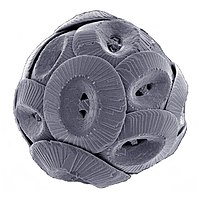
Photo from wikipedia
Prismatic layers are, depending on the taxonomy, aragonite or calcite [4, 5]. Calcite prisms of Pteriomorpha have geometrical shape, with polygonal sections (Fig. 1A-L), but their inner structure differs. The… Click to show full abstract
Prismatic layers are, depending on the taxonomy, aragonite or calcite [4, 5]. Calcite prisms of Pteriomorpha have geometrical shape, with polygonal sections (Fig. 1A-L), but their inner structure differs. The longitudinal faces of Pinna prisms are smooth (Fig. 1C), those of Pinctada are smooth, then corrugated (Fig. 1H) [6, 7], so that the growth mechanisms are not identical in these two taxa. Both species show growth layers (Fig. 1D, I) when etched using acidic or enzymatic solutions. Polarised light images show that the prisms are "monocrystalline" in Pinna, polycrystalline in Pinctada (Fig. 1E, F, J, K). Etched transverse sections clearly show the differences (Fig. 1G, 1L). Growth layers are also visible in chemical distribution maps (Fig. 1M, N), and every chemical element has its own deposition rhythm [8]. Organic envelopes surrounding the prisms of Pinna are rich in S (Fig. 1N). In Pinctada, the envelopes are poor in Ca associated components (Fig. 1O), rich in S (Fig. 1P), S being mainly associated with amino acids (Fig. 1Q) [9]. μXRF also shows the presence of Br in Pinctada (Fig. 1R), and the 3-layered structure of the envelope of Pinna (Fig. 1S). The complex structure of the interprismatic envelopes is also demonstrated using FTIR and TOF SIMS [9]. AFM images display the irregularity of the layers of the envelopes in
Journal Title: Microscopy and Microanalysis
Year Published: 2020
Link to full text (if available)
Share on Social Media: Sign Up to like & get
recommendations!